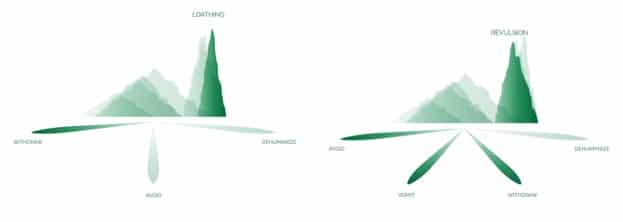CAN EXPERTS IN EMOTIONAL SCIENCE HELP US BETTER UNDERSTAND THE RELATIONSHIP BETWEEN TRIGGERS, EMOTIONS AND ACTIONS?
 The Dali Lama is the leader of the Buddhist faith, believed to be the 14th reincarnation of the same spiritual leader.
The Dali Lama is the leader of the Buddhist faith, believed to be the 14th reincarnation of the same spiritual leader.
Although exiled from Tibet, he still believes in peace and that science and religion don’t conflict. He approached Paul Ekmann, working with 248 other Emotional Scientists. Paul Eckmann’s work is discussed in the 2nd blog in this series. His idea, explained in this video, was to help develop a calm mind by understanding emotions:
How Many Emotions Are There?
The Atlas of Emotions
The Atlas of Emotions is an interactive website which is really interesting and easy to use. The hope is that if people are aware of their emotional state, they will choose a to make a more positive and constructive response. The analysis process below is simplified into easier steps compared to the process Sigmund Freud developed for psychoanalysis (Explained in the 3rd post in this series).
The interactive Atlas of Emotions site describes a timeline which starts with triggers and results in outcomes for the 5 emotional states, like these for anger, enjoyment and sadness.
Experience and Moods
The site represents the five emotions as differently coloured spheres made up of rings. These spheres change size and the rings have varying intensities as the emotions change in strength and importance.
When you select an emotional sphere it flattens out into peaks representing the individual “moods” making up the emotion. The higher the emotional peak and narrower the base the more intense that mood can be experienced.
Fear and its moods are coloured purple with sharp and angular peaks. Terror has a tall peak and narrow base showing it is a very intense emotion.
Disgust is coloured green with a wavy design. Dislike is the least intense mood with a wide base and low peak.
Enjoyment is coloured yellow/orange with a curved design. Ecstasy is intense and sensory pleasure has low intensity.
The “Response” tab breaks down each emotion into the constructive, destructive and ambiguous outcomes which might be available e.g. the four actions associated with Disgust are avoidance, dehumanisation, vomiting and withdrawal. Some moods have fewer responses e.g. loathing does not elicit vomiting. Some responses are shaded lighter showing it is less likely e.g. revulsion is less likely to result in dehumanisation.
The responses to the other emotions are in the screenshots below:
The Altas of Emotions is an easy to understand interactive tool which analyses behaviour in detail. It makes a more detailed associations between triggers, emotions and actions.
Designers can use the Atlas of Emotions to work from the emotion desired to establish the moods they need to create.
If the desired outcome is that the wearer/recipient of jewellery should experience Enjoyment then the designer needs to create a mood of Excitement, Wonder, Pride, Amusement, Joy or Rejoicing.
READ MY NEXT POST TO SEE WHETHER OTHER TECHNOLOGES CAN HELP DESIGNERS CREATE EMOTION AND FEELING …..
Definitions:
Pre-condition – the situation the person finds themselves in e.g. being hungry, tired, having a good day
Event – any situation, thought, memory, idea etc which can be real or imagined
Fear – We feel fear when our safety or wellbeing is threatened. Fear varies in strength and frequency in our lives.
Trepidation – Anticipation of the possibility of danger
Nervousness – Uncertainty of whether there is danger
Anxiety – Fear of an anticipated or actual threat and uncertainty about one’s ability to cope with it
Dread – Anticipation of severe danger
Desperation – A response to the inability to reduce danger
Panic – Sudden uncontrollable fear
Horror – A mixture of fear, disgust and shock
Terror – Intense, overpowering fear
Disgust – We feel disgust when faced with something toxic or unpleasant. Disgust varies in strength and frequency in our lives.
Dislike – A preference against something
Aversion – An impulse to avoid something disgusting
Distaste – Reaction to a bad taste, smell, thing or idea. Can be literal or metaphorical
Repugnance – Strong distaste for something, often a concept or idea
Revulsion – A mixture of disgust and loathing
Abhorrence – A mixture of intense disgust and hatred
Loathing – Intense disgust focused on a person. Intense disgust focused on oneself is called self-loathing
Enjoyment – We feel enjoyment when we experience novelty or comfort. Enjoyment varies in strength and frequency in our lives.
Sensory Pleasure – Enjoyment through one of the five physical senses: sight, sound, touch, taste and smell
Compassion/ Joy – Enjoyment of helping to relieve another person’s suffering
Amusement – Light, playful feelings of enjoyment and good humour
Fiero – Enjoyment of meeting a difficult challenge (an Italian word)
Pride – Deep pleasure and satisfaction derived from one’s own achievements or the achievements of an associate
Naches – Joyful pride in the accomplishments of one’s children or mentees
Wonder – An experience of something which is very surprising, beautiful, amazing or hard to believe
Excitement – A powerful enthusiasm
Ecstasy – Rapturous delight. A state of very great happiness, nearly overwhelming
Further reading if this topic is of interest to you:
The 14th Dalai Lama. (2020). His Holiness the 14th Dalai Lama | The 14th Dalai Lama. [online] Available at: https://www.dalailama.com/ [Accessed 29 Nov. 2019].
Youtube.com. (2014). YouTube. [online] Available at: https://www.youtube.com/watch?v=kL3ezGjE2Q4 [Accessed 19 Nov. 2019].
Design, S. (2020). The Ekmans’ Atlas of Emotion. [online] The Ekmans’ Atlas of Emotions. Available at: http://atlasofemotions.org/ [Accessed 23 Nov. 2019].

